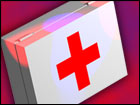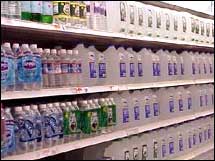|
What it costs to prepare for disaster
|
 |
November 9, 2001: 7:32 a.m. ET
A disaster supplies kit will help your family brace for the unexpected.
By Annelena Lobb
|
NEW YORK (CNNmoney) - There's no way to prepare for disaster, of course. Getting caught off-guard is part of what makes an event an emergency.
But the attacks on Sept. 11 and the war against terrorism have created a heightened sense of awareness among U.S. consumers, many of whom are stocking up on supplies at home - from first-aid kits to non-perishable food and basic tools.
"A preparedness kit is important in case you need to evacuate your home. Everything you need is in one central location and can be loaded onto a vehicle quickly. Alternatively, if you're confined to your home, but services like gas, electricity and water are knocked out, it's important you be self-sufficient until help arrives," said Steffen Strayer, a spokesperson for the Red Cross.
Assembling a supplies kit to deal with both man-made and natural disasters can be a complicated and sometimes pricey undertaking. Remember that the checklist varies somewhat, depending on the types of natural disasters most common to where you live.
"If you live in an earthquake-prone area, you'd need one kind of kit; if you live in a hurricane-prone area, the same things may not be appropriate," said John Schorr, a sociology professor and expert in disaster sociology at Stetson University in DeLand, Fla. "Consider what can put your family at risk, and think about what can help you cope with those conditions."
To cut the task down to size, the Federal Emergency Management Agency (FEMA) has a list of supplies they recommend to all. Here's a sampler:
First aid comes first
Every stash of disaster supplies needs to have a first-aid kit. If someone gets hurt and the emergency room is out of reach, a little bit of first aid can go a long way.
A good first-aid kit has bandages of every variety (Band-Aid bandages, assorted sizes, pkg. of 25; $3.59, cvs.com) and texture (2-inch sterile gauze bandages, 4 yards; $2.79, cvs.com). You'll also need scissors (Trim scissors, $8.99, cvs.com) to crop bandages that are too long, and sterile tape (Johnson & Johnson 2" hurt-free tape, 5 yards, $4.99, cvs.com) to secure gauze in place.
Cleanliness and hygiene are paramount, especially if you're bandaging a cut or burn. But a disaster may cut off your water supply, so make sure you have things like moist towelettes (CVS fresh 'n up wipes, pkg. of 50, $1.99, cvs.com) and antiseptic pads (Betadine solution swab-aid pads, pkg. of 100, $5.99, cvs.com) to clean wounds and injuries. To protect your hands, keep latex gloves (CVS disposable latex gloves, pkg. of 50, $6.99, cvs.com) in the kit as well.
Besides the items you'll need for first aid, keep essential medical supplies on hand - any prescription drugs that a family member takes daily, for example, such as insulin or high blood pressure medication.
It's also helpful to keep some non-prescription drugs on hand - aspirin and non-aspirin pain relievers (Advil tablets, pkg. of 50, $5.49; Bayer aspirin tablets, pkg. of 50, $3.79, cvs.com), antacids (Alka-seltzer effervescent tablets, pkg. of 24, $4.39, cvs.com), and emergency medications like ipecac (Humco ipecac syrup USP, 1 ml, $1.99, cvs.com).
Feeding the troops
A lot can go awry if your power lines go down. Fresh food will begin to perish. That's why it's important to keep canned goods and non-perishable items on hand. And, if you have no access to your water supply, it's absolutely crucial that you have a supply of potable water that can last at least a few days.
| |

|
|
Make sure everyone in your family has at least a three-day water supply. | |
FEMA recommends you stash high-energy foods in the kit, like peanut butter (JIF creamy peanut butter, 18 oz., $1.49, netgrocer.com), granola bars (Quaker granola bars, pkg. of 10, $3.29, netgrocer.com) and trail mix (Harmony snacks deluxe super trail mix, 3.5 oz., $1.29, netgrocer.com). Remember to buy enough of everything so each person in your family can eat for a few days.
Canned foods also work well. Try soups that don't require you to add water (Progresso chicken rice with vegetable soup, 19 oz., $2.29; Campbell's ready-to-serve tomato soup, 18.7 oz., $1.69, netgrocer.com). Canned juices (Dole pineapple juice, 46 oz., $1.99, netgrocer.com) also help extend your water supply.
Keep some comfort foods on hand, like hard candy (Jolly Rancher assorted fruits hard candy, 14 oz., $2.29, netgrocer.com) or instant coffee (Maxwell House Instant Coffee, 19 cups, $4.29, netgrocer.com) - and remember to set aside specialty foods like baby formula.
You can buy bottled water or set aside bottles of filtered tap water. If you do the latter, FEMA recommends you avoid using containers that can decompose or break, such as milk cartons or glass bottles. You should store one gallon of water per person per day (two quarts for drinking and two quarts for sanitation). Keep at least a three-day water supply for each person in your household.
Handy gadgets
You'll need some hardware and appliances to cope with an emergency scenario, too. First and foremost, keep several flashlights on hand (Mag-lite 2D cell flashlight, $19.99, sears.com, in case you lose power. You should keep a battery-operated radio for the same reason (Philips AM/FM/TV weatherband radio, $19.99, sears.com). That way you can keep abreast of the news if your TV is on the blink and the papers aren't coming.

|
|
|
If your power goes out, a battery-operated flashlight comes in handy. | |
To deal with flooding problems or pipes bursting, keep some plastic sheeting (Clear 4 Mil Polyethylene plastic sheeting, $5.92, homedepot.com) around to use as an all-purpose cover. Store matches in a tightly-sealed waterproof container. Get a bucket (Rubbermaid slate blue bucket, $3.97, homedepot.com).
Keep the supplies you'd most likely need during an evacuation in an easy-to-carry and preferably waterproof container.
For a full list of disaster supplies recommended by FEMA, click here. 
|
|
|
|
|
|

|

